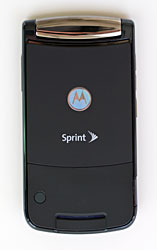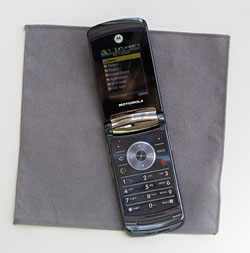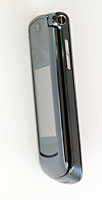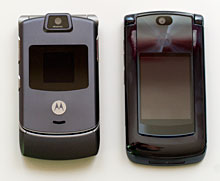
|
||||||||||
The phone’s web browser also loads pages quickly, but its rendering capability is pretty weak compared to browsers like Safari Mobile on the iPhone (currently the best browser on a phone). The browser makes a valiant effort to squeeze a standard web page into something that can be viewed comfortably on the screen of a cell phone, but this often just mangles the pages’ layout and makes them harder to navigate, rather than easier, and even modestly complicated JavaScripts on a web page tend to cause problems. In fact, I tried five different speed tests to gauge the exact speed of the EVDO data service (four of which were specifically designed for cell phone browsers), and the RAZR2’s browser could not complete any of the tests successfully, instead generating error messages. The sheer speed of web browsing takes its usability up a notch, but it would still be unpleasant to try to use the web browser for serious productivity or for an extended amount of time. 
Thankfully, Motorola did include expandable memory for the RAZR2 V9m, in the form of a microSD slot. You can store downloaded music and other content on removable microSD cards (which are currently available in capacities up to 2 GB), so, in theory at least, you don’t have to worry about running out of storage space. Another cool data feature on the RAZR2 is wireless backup, which allows you to store a copy of your phone book on Sprint’s computers, in case your phone is lost, stolen, erased, or destroyed. Even though customers frequently request this feature, relatively few phones provide it; however, you do still have the option to disable it if you are concerned about data privacy. There is, however, a bit of an issue with the RAZR2’s multitasking capabilities: it pretty much doesn’t have any. For example, you can browse the music store while listening to music tracks, but you can’t access any other areas of the phone while listening to music, so if you were hoping to listen to music while you work on, say, composing some text messages, you couldn’t really do that with this phone (unless you’re planning to buy two!). Additionally, loading certain programs on the phone sometimes causes an uninterruptible 5-10 second delay while the program starts up, which makes switching back and forth among programs even more frustrating—especially if you happen to start up the wrong program by mistake. Although limitations of this type are fairly standard on cell phones, this is one area where the iPhone beats the RAZR2 easily. (Fortunately, the RAZR2 does still have the ability to receive phone calls when you are using a different program on the phone.)
RAZR2 Bluetooth The RAZR2’s Bluetooth capabilities, certified as version 1.2, are impressive. It can, of course, handle basic tasks, like pairing with a Bluetooth headset and maintaining a connection so you can use the headset to make and receive calls (connections were stable and had good voice quality in testing), but in addition to the basics, it also supports A2DP, meaning that you can pair the phone with a set of Bluetooth headphones and listen to music playback wirelessly (in stereo). When used with Bluetooth headphones, the RAZR2 consistently produced high-quality audio. The one drawback here is that the RAZR2 does not have any sort of standard headphone jack. You can play music through the Moto's speaker, or you can listen over an A2DP-compatible Bluetooth headset, but if you want to use a wired headset, you will have to use a proprietary Motorola headset or adaptor.
The RAZR V3m and the RAZR2 V9m Finally, the RAZR2 supports the OBEX File Transfer profile, meaning that you can navigate its file system and transfer files over Bluetooth. (Most likely, you would pair the phone with your Bluetooth-capable computer to use these features.) It also supports DUN, so you can use it as a wireless high speed modem for a notebook over Bluetooth. Electric RAZR The standard lithium-ion battery included with the RAZR2 is rated at 3 hours of talk time, which is a bit low relative to other cell phones. The phone obviously has quite a few features, and the battery life will vary greatly depending on how you are using the phone. However, my tests indicate that three hours is indeed a reasonable estimate for talk time, provided that you minimize usage of any features that put extra drain on the battery. This is one phone that you’ll need to be careful about recharging frequently. Software In addition to the music player, SprintTV, Sprint Music Store, Sprint Radio, standard messaging programs, and the web browser, the RAZR2 includes a calendar, address book capable of storing 1,000 contacts, alarm clock, stopwatch, as well as calculators for converting units and currencies and for determining an appropriate tip, along with a general-purpose calculator. An application for recording and storing voice memos is also provided. Motorola has also included a file browser app for browsing and deleting files on the internal memory or the expansion card, which is a handy tool that should be included with all cell phones (but isn’t). Also included is OnDemand for access to the latest news and sports scores. RAZR Sharp The RAZR2 V9m has a lot to offer: great looks, solid built quality and a good set of features including EVDO (Sprint Power Vision) with Sprint TV, Sprint Radio, Sprint Music store and A2DP for wireless stereo music playback. We love the large external display that's the same resolution as the main display and almost as large. Nice, very nice. But is it worth the premium over other Sprint phones with a similar feature set? Currently it costs as much as the HTC Touch and Treo 700wx PDA phones, which is steep. If the looks and metallic finish along with the RAZR-chic are your thing, it might be worth the bucks. And the price will likely come down in a few months. Pros: Dual QVGA screens, great looks and solid build, streaming SprintTV, over-the-air music purchasing, supports A2DP, sharp camera. Cons: Web browser is limited; very little multitasking capability; some user interface lags; battery life is a little short. Pricey.
Web sites: www.hellomoto.com, www.sprint.com Price: $249 with 2 year contract
| ||||||||||







